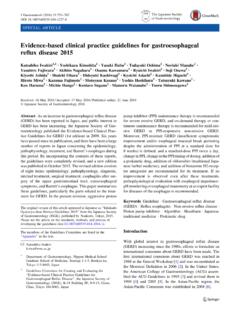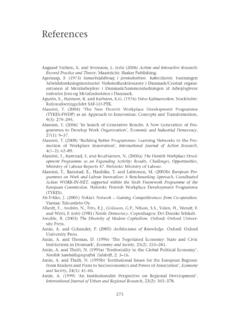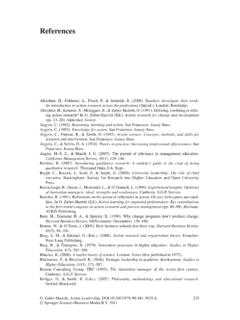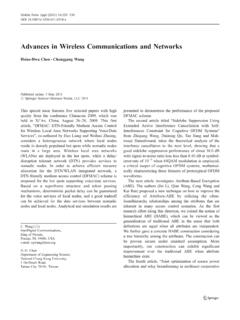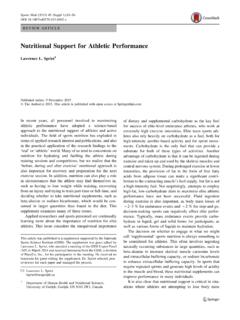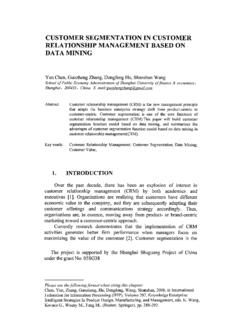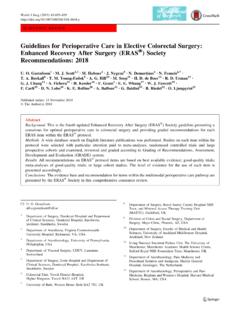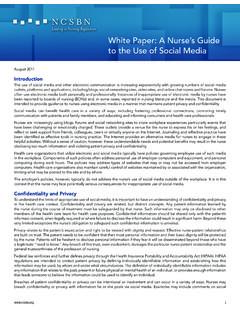Transcription of Appendix I Synthesizable and Non-Synthesizable ... - Springer
1 Appendix I. Synthesizable and Non-Synthesizable Verilog Constructs The list of Synthesizable and Non-Synthesizable Verilog constructs is tabu-lated in the following Table Verilog Used for Synthesizable Non-Synthesizable Constructs construct Construct module The code inside the module and Yes No the endmodule consists of the declarations and functionality of the design Instantiation If the module is Synthesizable Yes No then the instantiation is also Synthesizable initial Used in the test benches No Yes always Procedural block with the reg Yes No type assignment on LHS side. The block is sensitive to the events assign Continuous assignment with Yes No wire data type for modeling the combinational logic primitives UDP's are Non-Synthesizable Yes No whereas other Verilog primitives are Synthesizable force and These are used in test benches No Yes release and Non-Synthesizable delays Used in the test benches and No Yes synthesis tool ignores the delays fork and join Used during simulation No Yes ports Used to indicate the direction, Yes No input, output and inout.
2 The input is used at the top module parameter Used to make the design more Yes No generic time Not supported for the synthesis No Yes (continued). Springer India 2016 399. V. Taraate, Digital Logic Design Using Verilog, DOI 400 Appendix I: Synthesizable and Non-Synthesizable Verilog Constructs (continued). real Not supported for synthesis No Yes functions and Both are Synthesizable . Provided Yes No task that the task does not have the timing constructs loop The for loop is Synthesizable and Yes No used for the multiple iterations. Verilog Used for arithmetic, bitwise, Yes No Operators unary, logical, relational etc are Synthesizable Blocking and Used to describe the Yes No non-blocking combinational and sequential assignments design functionality respectively if-else, case, These are used to describe the Yes No casex, casez design functionality depending on the priority and parallel hardware requirements Compiler Used during synthesis Yes No directives ( ifdef, undef, de ne).
3 Bits and part It is Synthesizable and used for Yes No select the bit or part select Appendix II. Xilinx Spartan Devices Xilinx Spartan 3 Devices Springer India 2016 401. V. Taraate, Digital Logic Design Using Verilog, DOI 402 Appendix II: Xilinx Spartan Devices Spartan 3 Family Architecture Xilinx Spartan 3 Package information for Part no XC3S400-4PQ208C. Appendix II: Xilinx Spartan Devices 403. For more information please use the following link documentation/data_ Xilinx FPGA Spartan 3E Devices Xilinx Spartan 3E Architecture 404 Appendix II: Xilinx Spartan Devices Xilinx Spartan 3E package information For more information please use the following link documentation/data_ Appendix III.
4 Design For Testability The Design For Testability (DFT) and its necessity is discussed in summarized In the practical ASIC design, the DFT is used to nd out various kinds of faults in the design. For FPGA designs this step is excluded. The necessity of DFT is for early detection of the faults in the design using scan chain insertions. The func- tional abstraction of defects is called as fault and the abstraction of the fault is the system level error. Physical testing is carried out after manufacturing of chip to understand the fabrication-related issues or faults. The defects in the design can be physical or electrical. Physical defects are due to silicon or defective oxide.
5 Electrical defects are short, open, transistor defects and changes in the threshold voltage. Few of the faults in the design are following 1. Stuck at faults: Stuck at one or Stuck at zero 2. Memory faults or pattern-sensitive faults 3. Bridging faults 4. Cross point faults 5. Delay faults Testing process is the process of test pattern generation, test pattern application and output evaluation. Generally, the test ow includes the following: 1. Identify the target faults 2. Test generation 3. Fault Simulation 4. Testability 5. DFT. Design For Testability (DFT). The DFT is required to reduce the defect level in the design. Consider the following design; in this design it is not possible to give the test input so design is not testable.
6 The DFT uses the concept of controllability and observabilty. The key steps are Springer India 2016 405. V. Taraate, Digital Logic Design Using Verilog, DOI 406 Appendix III: Design For Testability 1. RTL design 2. Simulation 3. Synthesis 4. Insert scan chain 5. Layout If every data input of the register need to be forced to the known value during the test, then the design is controllable. Observability indicates the ability to observe the node at primary output. The de-sign needs to be controllable and observable. As shown in the following design, the design input of comb_logic1 is control- lable and the output from comb_logic3 is observable.
7 But comb_logic1 and comb_logic2 are not observable. So for detection of faults, it is essential to make comb_logic1, comb_logic2, and comb_logic3 controllable as well as observable. comb_l comb_l comb_l ogic1 ogic2 ogic3. clk The basic DFT techniques are: Ad-HOC DFT and Structured DFT. The struc- tured DFT includes the scan-based DFT which is again classi ed as MUX - based DFT and level sensitive, element-based DFT. An-other structured DFT. technique is MBIST and LBIST. JTAG is used for boundary scan. Basic MUX-based technique is described below. MUX-based scan cell The MUX-based scan cell is shown below and it has additional inputs as Test_data, Scan_en.
8 The MUX is inserted at the input of the D ip- op and during testing Scan_en=1 the D input is Test_data. During normal operation, the Scan_en=0 and Data_in can pass through the combinational logic to the D input. Thus, the following cell works both in the test and normal modes. The clk can be scan_clk during the test mode. Appendix III: Design For Testability 407. Data_in comb_l Q_out ogic2. D. Test_data Scan _en clk MUX-based scan chain: Normally used method is insertion of scan by using MUX logic. MUX-based scan cell shown in the above gure is used to replace the sequential elements from the design. Depending on the requirements the design team decides whether to use partial scan method or full scan method.
9 In the partial scan method few of the sequential elements are replaced by the MUX based scan cell. In the full scan method, all the sequential elements are re-placed by the MUX-based scan cell. Due to scan insertion, the area and timing of the design has signi cant impact. Scan insertion increases the area of the design and due to added MUX-based logic even it affects on the timing of the design. The following example shows the scan chain using MUX-based scan cells. Most of the time, the partial scan is recommended if area and timing is the constraint but this reduces overall fault coverage. If full scan is used then it increases area and has signi cant impact on timing but this improves overall fault coverage.
10 Comb_. Data_in comb_. logic2. logic1. D D comb_. Test_data logic3. Scan _en clk 408 Appendix III: Design For Testability Scan Design rules Following are few of the scan design rules need to be considered: 1. Generated clocks in the design: There should not be generated clocks in the design as they are not controllable 2. Combinational feedback loop: There should not be any combinational loop in the design as it creates issues in the timing analysis and hence it is essential to break the combinational loop 3. Gated clocks: Gated clocks need to be avoided as they are not controllable 4. Asynchronous Control signals: There should not be any internally generated asynchronous control signals 5.
